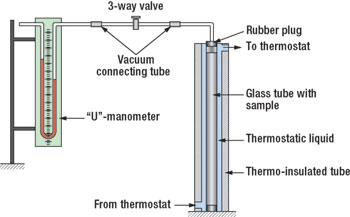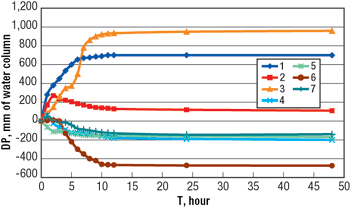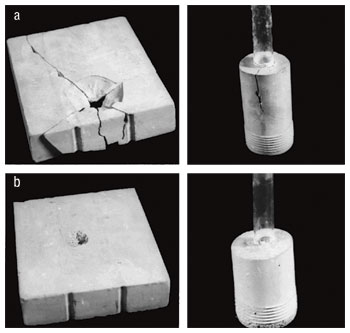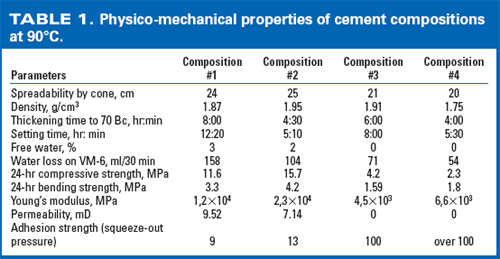Drilling Report
Compressible cement compositions improve isolation
An inexpensive cement additive has proven highly effective over many years and wells in preventing fluid migration, even in Russia’s geologically difficult fields.
Anatoly A. Klyusov, VNIIGAZ Ltd; Zafir M. Fattakhov, Karachaganak Petroleum Operating B.V.; and Vsevolod A. Klyusov, Burgaz Drilling Company (GAZPROM Co.).
Reliable sealing of the annular well space with cement for preventing cross-flows, gas migration and sustained casing pressures is, of course, essential. In some of the main oil and gas fields of Russia, the problem is aggravated by complex geological factors. An example is the Arctic fields of the Urengoy group, Yamal peninsula, with up to 600 m of permafrost, high formation pressures, and formations that are soft and susceptible to fracturing. Another example of a problem area is the southern fields of the pre-Caspian depression, with the presence of salts, H2S, CO2 and high formation pressures (up to 60 MPa) and temperatures (>120°C).
The simple, inexpensive and well-known additive, vermiculite, has proven to be a successful solution for solving this problem in these fields. This article makes a case for why operators should not discount this somewhat obvious, proven solution.
PROBLEM OVERVIEW
Texas University and Exxon Co. jointly carried out tests on a well model1 and the analysis of field data performed by Louisiana University2 have confirmed the fact that the cement slurry column shows a hydrostatic pressure drop in the annulus immediately after cementing. This pressure loss results from contraction, i.e., a decrease in absolute volume of the cement-water system in the hydration process. This happens at the expense of free-water transition (density 1.0 g/cm3) into adsorption, and crystalline hydrate water (density of 1.05 – 1.30 g/cm3).
At the same time, an apparent volume increase, as first noted by Le Chatelier, can occur, due to pore-structure development. The most intensive hydrostatic pressure drop of the cement slurry column is observed after completion of the “dormant-period,” which occurs in the transition process from coagulation to crystalline structure. The failure of contact zones with casing and rock takes place as a result of shrinkage, as well as from the dynamic and thermal impacts on casing, after cement hardening.
The use of compressible cement compositions, which have a minimum degree of destruction and modulus of elasticity, is an effective method for preventing gas migration during waiting-on-cement time. This allows the cement to compensate for alternate loads and stresses in the contact zone, making the well a single system. Known methods of aeration of cement slurries with nitrogen3 or gas-generating additives (e.g., aluminum powder) do not achieve desired results in many cases, because of phase separation due to temperature and pressure gradients along the borehole, and because of a large amount of cement destruction.
 |
Fig. 1. Scheme (a) and model (b) of expanded vermiculite behavior in cement slurry.
|
|
THE SOLUTION: MECHANISM AND PROPERTIES
Addition of expanded vermiculite sand, as an air-entraining admixture into cement slurry, solves the above problem. Air is trapped between layers in a vermiculite particle that acts as a damper, Fig. 1. This provides the following advantages:
- Prevents hydrostatic pressure loss of cement slurry column on the reservoir during waiting-on-cement
- Prevents cement shrinkage
- Compensates for stresses in cement matrix, including those taking place during cement slurry freezing in a closed space and recrystallization of new products (e.g., during the reactions C4AH13 g C3AH6 or CAH10 g C3AH6). This is necessary for a long, stable expansion in expanding cements and prevention of corrosion failure of cement with an increased chloride content
- Decrease in destruction degree (scomp/sbend < 3) and an increase in fracturing resistance of cement at thermal and dynamic loads
- Increases thermal resistance and insulation. This creates favorable conditions for forming a defect-free cement sheath under large temperature differences between casing and rock.4 The latter is especially important for arctic and steam wells.
Larger, compared to cement, plate-like vermiculite particles (0.6 – 1.6 mm) orienting themselves along a flow, promote the plugging of permeable reservoirs and increase the formation fracture gradient.
In the process of displacing to bottomhole, the vermiculite-cement slurry compresses, while it expands at the annulus inlet. Two competing processes limit the slurry compression-expansion:
- Compression due to the hydrostatic pressure of the cement slurry column, together with injection pressure
- Temperature expansion of “trapped” air – a 100-fold increase, as compared to the solid phase.
In this connection, an improperly designed composition, containing an excessive amount of vermiculite sand, can lead to increasing the injection pressure at the annular space inlet, squeezing the casing with slurry and lifting it. These phenomena have been observed in field practice.
Laboratory experiments. We have studied the influence of various cement compositions with respect to: 1) pressure during cement hardening; 2) permeability of the cement samples formed in a tube at various temperatures; and 3) their bonding with the tube’s surface.
The study of the pressure change in the process of hardening was performed with a test set (Fig. 2), comprising a glass tube (d = 30 mm, L = 130 cm) with a cement sample contained in a thermostating jacket, and connected to a U-type manometer by a three-way valve, immediately after equalizing the temperatures of the thermostating liquid and the sample.
 |
Fig. 2. Test set scheme for study the pressure change in process of cement hardening.
|
|
The following six cement compositions were investigated (Fig. 3):
- Non-freezing vermiculite-bentonite in a diesel base
- Vermiculite-cement mixture at 20°C
- Salt-saturated vermiculite-cement at 90°C
- Bentonite cement at 20°C
- Class G cement with microspheres at 20°C.
- G cement, at 20°C and 90°C
 |
Fig. 3. Dynamics of change in cement slurry column pressure DP vs. time T.
|
|
Based on these mixtures, the dynamics of pressure change of the slurry column indicates that, the standard cement slurry, on the basis of Class G cement at temperatures of 20°C and 90°C and its compositions with glass microspheres and bentonite powder, shows intensive pressure loss after 2 – 3 hours of hydration. However, introduction of expanded vermiculite increases cement column pressure. By using the above compressible systems, an insignificant annulus pressure (up to 0.3 MPa) can be registered at the wellhead, thus creating the illusion of real annulus pressure. But in fact, this pressure is not connected with reservoir pressure. Rather, it is caused by the swelling of expanding vermiculite particles and thermal expansion of air inclusions.
Cement slurry, reinforced with plate-like granules of expanded vermiculite, has high resistance to gas migration. This is proven by experiments carried out in a vertical glass tube filled with vermiculite-cement slurry immediately after its preparation. Gas pressure that exceeded the slurry column pressure by 0.03 MPa was applied from the tube bottom through a glass filter. Here, replacement of the slurry as a “piston” was observed, while excess pressure, greater than the cement column pressure, with a normal density of 1.92 g/cm3 without vermiculite, led to gas migration through the slurry with the development of a cone in the process of cement hardening.
The introduction of 1 – 2% (of cement mass) of expanded vermiculite may increase the cement crack resistance in adjacent perforation intervals. Cement crack resistance was determined by two methods (Fig. 4).
 |
Fig. 4. Crack-resistance of Class G cement (a) and G cement blended with 2% expanded vermiculite (b).
|
|
In the first, cement samples, 16 × 16 × 4 cm in size, were formed in metal moulds at 90°C. After 3 – 7 days they were shot from a rifle at a distance 10 m.
In the second test, samples were formed between glass cylinders. After one day of curing, the samples were removed from the cylinders. Cracks had formed along the trend of the cement. The results indicate that pure cement splits up into separate pieces after shooting, and under static conditions, is characterized by longitudinal and radial cracks from tensile stresses, in contrast to cement with added expanded vermiculite.
The permeability and bonding strength of cement compositions were determined directly on the cement samples contained in metal tubes (d = 22 mm, L =150 mm). They were allowed to cure for one day at a temperature 90°C with closed end plugs to maintain tightness. Table 1 illustrates the results of tests of salt-saturated samples made of different cement compositions:
Composition 1: Mixed cement containing slag, silica flour and Class G cement
Composition 2: Class G cement
Composition 3: Mixed cement containing Class G cement, silica flour and 2% expanded vermiculite
Composition 4: Mixed cement containing Class G cement and 5% expanded vermiculite.
The test results shown in the Table indicate that samples containing expanded vermiculite are impermeable under equal test conditions, whereas samples without the additive have permeabilities of 9.52 and 7.14 mD, respectively. The pressure of squeezing out samples containing expanded vermiculite exceeded the maximum possible during the testing (100 MPa).
Field results. Since intensive development began in the Urengoy gas condensate field in 1982, over 1,500 gas and gas condensate wells were cemented with vermiculite-cement compositions. In the period of maximum fluid withdrawal, the number of wells with sustained casing pressures did not exceed 10%, and in the period of declining recovery, only 2%. It should be noted that the assessment of well cementing using acoustic cement-bond logging did not work as well as in conventional cement, contributing to difficulties when handing wells over to the customer. This was due to the acoustic damping properties of expanded vermiculite.
CONCLUSION
Tests have confirmed the active mechanism of expanded vermiculite in the structure of cement. This cement composition is an improvement to other lightening additives such as bentonite and microspheres, as it allows the following:
- Prevents the hydrostatic pressure fall of the cement on the reservoir during the waiting-on-cement period, as well as cement shrinkage
- Increases impermeability and bond strength of cement with the bounding surface
- Increases crack resistance of cement, even under dynamic loads
- In contrast to aerated systems, avoids separation of phases under the harsh well conditions of temperature and pressure gradient.
These of expanded vermiculite promote high-quality cementing, even in the presence of complicated geological factors. 
Editor’s note: The reader should be aware that there are potential HSE considerations with the use of vermiculite with respect to dust and occasional association with asbestos. However, when mined and handled properly, there are no known negative health effects.
LITERATURE CITED
1 Levine, D., E. Thomas, H. Bezner and G. Tolle, “How to prevent annular gas flow following cementing operations,” World Oil, Vol. 191, No. 5, p. 85, October 1980.
2 Wojtanowicz, A., W. Manowski and S. Nishikawa, “Gas Flow in Wells after cementing,” Final report, Louisiana State University, Raton Rouge, Louisiana, 56, September 5, 2000.
3 Petitt, I., R. Covington, “Foamed cements reliably seal cased wellbores,” Oil and Gas Journal, p. 58, July 24, 2000.
4 Klyusov, A., A. Ryabokon, V. Klyusov, “Cement and well cementing in Arctic Zone of Russia,” Conference Natural Gas Technologies, Orlando, Florida, September 30 – October 2, 2002.
THE AUTHORS
|
 |
Anatoly A. Klyusov is head of the Well Cementing and Completion Laboratory of VNIIGAZ, GAZPROM Co. In 1963, he graduated from the Leningrad Technological Institute as cement technology engineer. He earned a PhD in 1973 and DSc in 1993 from Mendeleev Chemistry Technological Institute in Moscow. Between 1968 and 1994, he worked in Tyumen (Western Siberia) as head professor of Plugging Material Laboratory of Oil and Gas Geology Institute and head of chair in Architectural-Building Academy. He is the author of 215 papers and 44 patents of RF. Cementlab@nv.vniigaz.gazprom.ru
|
|
 |
Zafir M. Fattakhov is a well integrity and ICP problems engineer for Karachaganak Petroleum Operating B.V. Until November 2004, he was a Principal Scientist of Well Cementing and Completion Laboratory at VNIIGAZ, GAZPROM Co. He has more than 17 years field and research experience in well cementing, diagnosis and remediation of sustained casing pressures under H2S and high pressure conditions. He holds a PhD degree in drilling and development engineering from Ufa State Technical Petroleum University. Fattakhov has published several technical papers and holds patents in cementing and diagnosis and elimination of SCP. FattaZ@kpo.kz
|
|
 |
Vsevolod A. Klyusov is a senior specialist in the Drilling Department of Burgaz Drilling Co., GAZPROM Co. He graduated in 1998 from the Tyumen Oil and Gas University. Thereafter, he took post-graduate courses in Tyumen Architectural-Building Academy and earned a PhD in 2000 in drilling from Tyumen Oil and Gas University. He has authored more than 35 scientific articles and holds 7 patents of Russian Federation. VAKlusov@burgaz.gazprom.ru
|
|










